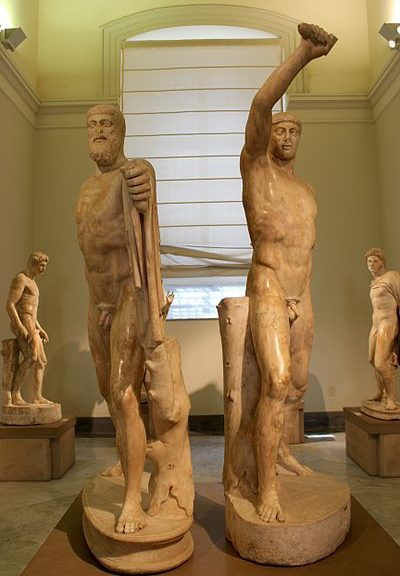
Achilles Binding Patroclus’ Wounds (500 BCE)
 Achilles Binding Patroclus’ Wounds
Achilles Binding Patroclus’ Wounds
Artist: Sosias Painter
Date & Location: 500 BCE in Greece
Media: Painted Pottery (Kylix Vase)
Where can I see this artwork?: Antikensammlung in Berlin, Germany
Significance to Queer Art History:
Achilles and Patroclus, are one of the most celebrated male warrior pairs in Greek literature after the Trojan War. Achilles is a young Greek warrior in Homer’s Iliad who possesses superhuman strength and ability as he was born from a nymph and a mortal. He is known for his only weakness being in his heel as his mother dipped him in the river Styx as an infant and held him by his heel. Patroclus is a warrior who grew up as a role model and companion to Achilles as appointed by Achilles’ father.
Homer, the poet writes the pair as two friends with a tender relationship later deemed as pederastic by the Greeks, where in which an older male figure mentors and cares for the younger as a “rite of passage” that could include sexual relations. After the death Patroclus, Achilles’ aim for fighting in the war became Patroclus. Achilles’ grief causes him insomnia and a great drive to fight and avenge Patroclus’ death at the hands of Hector, a Trojan prince and fighter for Troy. After Homer’s Iliad, the two can be found in art and literature demonstrating their bond and companionship.
Resources and Further Reading:
Gabriel Laguna-Mariscal, and Manuel Sanz-Morales. “Was the Relationship between Achilles and Patroclus Homoerotic? The View of Apollonius Rhodius.” Hermes 133, no. 1 (2005): 120-23. http://www.jstor.org.proxy.library.cpp.edu/stable/4477639.
Morales, Manuel Sanz, and Gabriel Laguna Mariscal. “The Relationship between Achilles and Patroclus According to Chariton of Aphrodisias.” The Classical Quarterly 53, no. 1 (2003): 292-95.
Winters, Riley. “Achilles and Patroclus: Brothers from Other Mothers or Passionate Paramours?” Ancient Origins. 2017. https://www.ancient-origins.net/myths-legends-europe/achilles-and-patroclus-brothers-other-mothers-or-passionate-paramours-008265.





